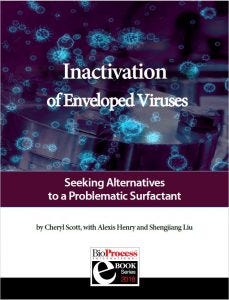Inactivation of Enveloped Viruses: Seeking Alternatives to a Problematic SurfactantInactivation of Enveloped Viruses: Seeking Alternatives to a Problematic Surfactant
November 10, 2018
 Triton X-100 detergent makes an interesting case study in bioprocess sustainability strategy. Also known as octylphenol ethoxylate (OPE), this nonionic surfactant has many uses in biopharmaceutical research and development. Among other laboratory applications, it is used to lyse cells and DNA in research, to solubilize membrane proteins and decellularize animal-derived tissues, to reduce the surface tension of aqueous solutions during immunostaining, and to remove sodium dodecyl sulfate (SDS) from polyacrylamide gel electrophoresis (PAGE) gels for analysis. It also serves as a vaccine excipient and most notably a virus-inactivation agent in downstream processing. Despite a long history of industrial use and an established safety profile, OPE has been listed in Europe as a “substance of very high concern” because it recently has been shown to degrade in the environment to yield an endocrine disruptor. Consequently, many users are looking for alternatives — especially for high-volume uses such as viral inactivation of large-scale product streams.
Triton X-100 detergent makes an interesting case study in bioprocess sustainability strategy. Also known as octylphenol ethoxylate (OPE), this nonionic surfactant has many uses in biopharmaceutical research and development. Among other laboratory applications, it is used to lyse cells and DNA in research, to solubilize membrane proteins and decellularize animal-derived tissues, to reduce the surface tension of aqueous solutions during immunostaining, and to remove sodium dodecyl sulfate (SDS) from polyacrylamide gel electrophoresis (PAGE) gels for analysis. It also serves as a vaccine excipient and most notably a virus-inactivation agent in downstream processing. Despite a long history of industrial use and an established safety profile, OPE has been listed in Europe as a “substance of very high concern” because it recently has been shown to degrade in the environment to yield an endocrine disruptor. Consequently, many users are looking for alternatives — especially for high-volume uses such as viral inactivation of large-scale product streams.
In this exclusive eBook, BPI’s senior technical editor reviews the problem and potential solutions in the works, including discussion with scientists at Bayer and Biogen.
You May Also Like





